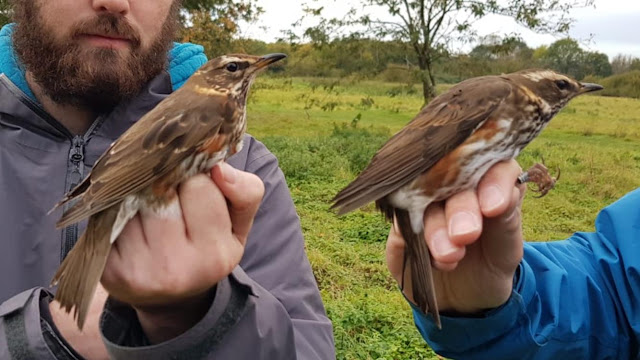Despite it being statistically the best month of the year for rare birds, up until this weekend October had been rather quiet. Sure, there were plenty of flood waters and lots of birds to look through but it was pretty much the same birds each day. To give you an idea of what was generally around below are the WeBS (the monthly countrywide wetland bird survey that is carried out each winter) counts from Thomas Miller.
Garganey 1
Greylag 296
Barnacles 209
Canada 249
Wigeon 422
Teal 56
Mallard 1
Gadwall 1
Pintail 1
Golden plover 58
Lapwing 25 + 44 over
Bhg 243
Common gull 1
Herring gull 1
Lbbg 2
Little egret 1
Firstly, it was nice to see that the Garganey was still around. It hadn't been reported since it was originally found and it just shows how easily missed it is that has (presumably) been here all this time.
I was finally able to do some gulling this weekend - a luxury I am no longer able to do during the week due to work commitments. On Saturday there were barely a couple of dozen large gulls in the roost but quite late on one intriguing bird flew in which caught my eye. The mantle was really dark being just one shade off a Lesser Black-backed Gull and it had a very neatly defined streaked head. It flew in and immediately tucked itself up and went to sleep. I only had the briefest of views of its head but the bill did look reasonable for an Azorean Yellow-legged Gull (which was what I was thinking, given the other characteristics). Given how dark it was and the fact that it never moved from being asleep I wasn't able to get better video footage. In discussion with Ian Lewington it was agreed that really decent head and wind shots would be required to clinch the ID. I'm just hoping that either it returns to the Meadow or it's found at one of the other county sites during the day where the ID will be confirmed.
 |
| It's the bird in the centre behind and to the left of a Lesser Black-backed Gull |
Just to give you an idea of what an Azorean Yellow-legged Gull should look like, this is a picture of the one at Appleford 11 years ago.
 |
| Courtesy of Ian Lewington |
A lazy Sunday morning en famille was turned upside down mid morning when Ollie Padget messaged that a Glossy Ibis had just flown in and settled on the floods. I rushed down there and managed to see it for all of one minute on the ground before it flew up, spiralled around for a few minutes before drifting off to the north east.
Some video footage courtesy of Ollie Padget
 |
| A record shot that I took whilst it was spiralling around for a while |
About three quarters of an hour later a "probable" Glossy Ibis was seen at Otmoor so it may well have relocated there. This is just the second record of this species on the Meadow, the first one being in May 2014 - yet another good bird for the Meadow in what is turning out to be a vintage year.
I was back Sunday evening for the gull roost along with Ollie and Thomas Miller. Sadly there were almost no large gulls at all and no sign of "Ozzie" the Azorean. However, Thomas managed to confirm his credentials as the new county "gull whisperer" by finding two (adult and 2nd winter) Mediterranean Gulls in the space of a few minutes - something I've failed to do in several weeks of searching. This was the second year tick to be added within the same day so a very productive day!


